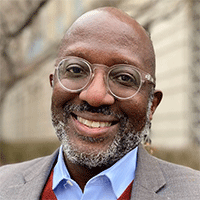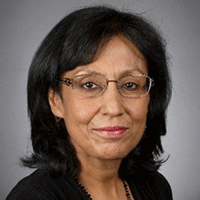
Jaret C. Riddick, PhD
Senior Fellow, CSET
Georgetown University
Presentation Title: Nanomaterials: Then, Now and Over the Horizon – Policy Implications
Abstract: The arc of my research career has tracked closely with the emergence of nanomaterials research in the United States. In 1991, the seminal Nature publication "Helical microtubules of graphitic carbon" announced Sumio Iijima's discovery of carbon nanotubes (CNTs). By 1993, when Iijima and Donald Bethune of IBM simultaneously discovered how to synthesize single-wall CNT, I was a recent college graduate launching a research career in computational structural mechanics focused on fiber-reinforced polymer composites. In 2000, U.S. President Bill Clinton announced the US Nanotechnology Initiative (NNI). By 2003, I was a recent PhD graduate when then U.S. President George W. Bush signed into law the 21st Century Nanotechnology Research and Development Act making the NNI official. Over the two decades since my nanomaterials research has touched upon an array of areas including multifunctional structural applications and advanced hierarchical modeling. Other breakthrough technological advances in nanomaterials over the same period included material synthesis, electro-optical and electro-magnetic applications, semiconductors, battery technology, and drug delivery. This presentation will focus on analysis of the nanomaterials research landscape using the Map of Science from the Emerging Technology Observatory (ETO) project of Georgetown University's Center for Security and Emerging Technology (CSET). ETO’s Map of Science includes over 130 million scholarly publications from around the world, algorithmically organized into over 116 thousand research clusters – groups of papers that cite each other most often.
The presentation will highlight key trends, hotspots, and concepts identified by filtering research clusters according to growth over time, key topics, countries, and other characteristics. I will also discuss what these trends mean for technical policymakers. Finally, I will explore what’s likely to be next in nanomaterials using the tools provided by the Map of Science and discuss the implications for technical policy.
Biography: Dr. Jaret Riddick is a Senior Fellow at Georgetown University’s Center for Security and Emerging Technology (CSET). Prior to joining CSET, he was the Principal Director for Autonomy in the Office of the Under Secretary for Research and Engineering (OUSD(R&E)), serving as the Senior DOD official for coordination, strategy, and transition of Autonomy research and development. As Principal Director, he created a DOD-wide initiative on trusted Autonomy, led efforts to advance Autonomy for undersea warfare with allied partners, and provided key strategic analysis to support development of the newest DOD university-affiliated research center (UARC). Prior to OUSD(R&E), Jaret served in executive leadership roles in the US Army Research Laboratory (ARL), where he established a 200-acre robotics research collaboration campus and led ARL Senior leadership efforts to establish the research competencies of the Laboratory. He has also served in leadership roles in the Office of the Deputy Assistant Secretary of the Army for Research and Technology, and the former Office of the Under Secretary of Defense for Acquisition, Technology and Logistics. He holds a Ph.D. in Engineering Mechanics from Virginia Tech, M.S. in Mechanical Engineering from North Carolina A&T State University, and B.S. in Mechanical Engineering from Howard University.

Adaptive Structures Award Recipient
Aditi Chattopadhyay
Regents' Professor
Arizona State University(ASU)
Presentation Title:Multiscale Methodologies for Multifunctional Material Design
Abstract: There is an increased need for new and improved materials with unprecedented functionalities, and tailorable properties to enhance mobility, maneuverability, survivability, and transportability of aerospace and other assets. The success of such material development requires a strong understanding of mechano-chemical interactions at the constituent scales and their implementation requires a deeper understanding of deformation, damage, and time to failure in service environment, which depends on a multitude of variables that are stochastic and multiscale in nature. This talk will focus on our research on computationally assisted and experimentally validated high-fidelity models that incorporate multi-physics constitutive laws, scale-dependent experiments, and machine learning to advance the understanding of material failure allowing the exploitation of the multifunctional features for optimum design of advanced materials for use in NextGen applications.
Biography: Dr. Aditi Chattopadhyay is a Regents' Professor at Arizona State University (ASU). She is the Ira A. Fulton Chair Professor of Mechanical and Aerospace Engineering in the School for Engineering of Matter, Transport and Energy and the Director of the Adaptive Intelligent Materials & Systems (AIMS) Center at ASU. She received her B. Tech (Hons) in Aerospace Engineering from the Indian Institute of Technology Kharagpur, followed by M.S. and Ph. D. degrees in Aerospace Engineering from the Georgia Institute of Technology. Her current research areas include multifunctional materials and adaptive structures, high-temperature materials, multiscale modeling, and systems health management. She has been the PI on numerous grants and has collaborated with defense and government labs on significant technical transitions. She graduated 44 Ph. D. students and 25 MS students and supervised 20 Postdoctoral Fellows and 4 Research Assistant Professors. She has published 246 archival journal papers, 385 refereed conference publications, book chapters, and NASA TMs, and is the holder of 5 patents. She is the recipient of several academic, research and best paper awards. She received the Georgia Institute of Technology Council of Outstanding Young Engineer Award and the Distinguished Alumnus Award from the Indian Institute of Technology. She is the recipient of the Faculty Achievement Award – Excellence in Research, Arizona State University. She has served as an associate editor and/or editorial board member of many journals and is currently serving on the editorial board of Journal of Structural Durability and Health Monitoring and Digital Engineering and Digital Twin. She serves on the technical committees of many professional organizations. Dr. Chattopadhyay is a Fellow of American Institute of Aeronautics & Astronautics (AIAA) and a Fellow of American Society of Mechanical Engineers (ASME).

Nanshu Lu, PhD
Frank and Kay Reese Professor
Department of Aerospace Engineering & Engineering Mechanics (ASE/EM)
Department of Biomedical Engineering (BME)
Department of Electrical and Computer Engineering (ECE)
Department of Mechanical Engineering (ME)
Texas Materials Institute (TMI)
The University of Texas at Austin
Austin, TX
Presentation Title: E-Tattoos and E-Skins Bridging Humans and Robots
Abstract: Many of us share a vision for the future that humans will be more like robots (i.e., digital, computational, cyber, expandable, etc.) whereas robots will be more like humans (i.e., soft, dexterous, intelligent, energy efficient, etc.). My group therefore focuses on soft electronics that can be integrated on humans or robots to facilitate their understanding and interaction. This talk will introduce my research on the mechanics, design, and manufacture of stretchable electronics. In particular, epidermal electronics, a.k.a. e-tattoos, represent a class of stretchable circuits, sensors, and stimulators that are ultrathin, ultrasoft, noninvasive but skin-conformable. My group has invented a dry and freeform "cut-and-paste" fabrication process for the rapid prototyping of multi-material, large-area, or modular e-tattoos capable of high-fidelity and ambulatory biometric sensing. While e-tattoos are for human wear, e-skins are for robot wear to emulate the functionalities and properties of human skins. Soft touch-sensitive e-skins have long been desired, but contamination of pressure responses by stretching has been a persistent challenge. My group recently developed a stretchable hybrid response pressure sensor (SHRPS) that solves this problem. SHRPS-integrated inflatable probes can be used for either accurate and gentle digital palpation or conformable and firm gripping. With e-tattoos digitizing the human body and e-skins mimicking human skin, we aim to bridge the gap between humans and robots for a symbiotic future.
Biography: Dr. Nanshu Lu is the Frank and Kay Reese Professor at the University of Texas at Austin. She received her B.Eng. with honors from Tsinghua University, Beijing, her Ph.D. from Harvard University, and then Beckman Postdoctoral Fellowship at UIUC. Her research concerns the mechanics, materials, manufacture, and human or robot integration of soft electronics. She is a Clarivate (Web of Science) highly cited researcher and a Fellow of the American Society of Mechanical Engineers (ASME). She is on the Board of Directors of the Society of Engineering Science (SES). She is currently an Associate Editor of Nano Letters and Journal of Applied Mechanics. She has been named 35 innovators under 35 by MIT Technology Review (TR 35) and iCANX/ACS Nano Inaugural Rising Star. She has received US NSF CAREER Award, US ONR and AFOSR Young Investigator Awards, 3M non-tenured faculty award, and the ASME Thomas J.R. Hughes Young Investigator Award. She was selected as one of the five great innovators on campus and five world-changing women at the University of Texas at Austin. For more information, please visit Dr. Lu’s research group webpage and follow her on Twitter: @nanshulu.